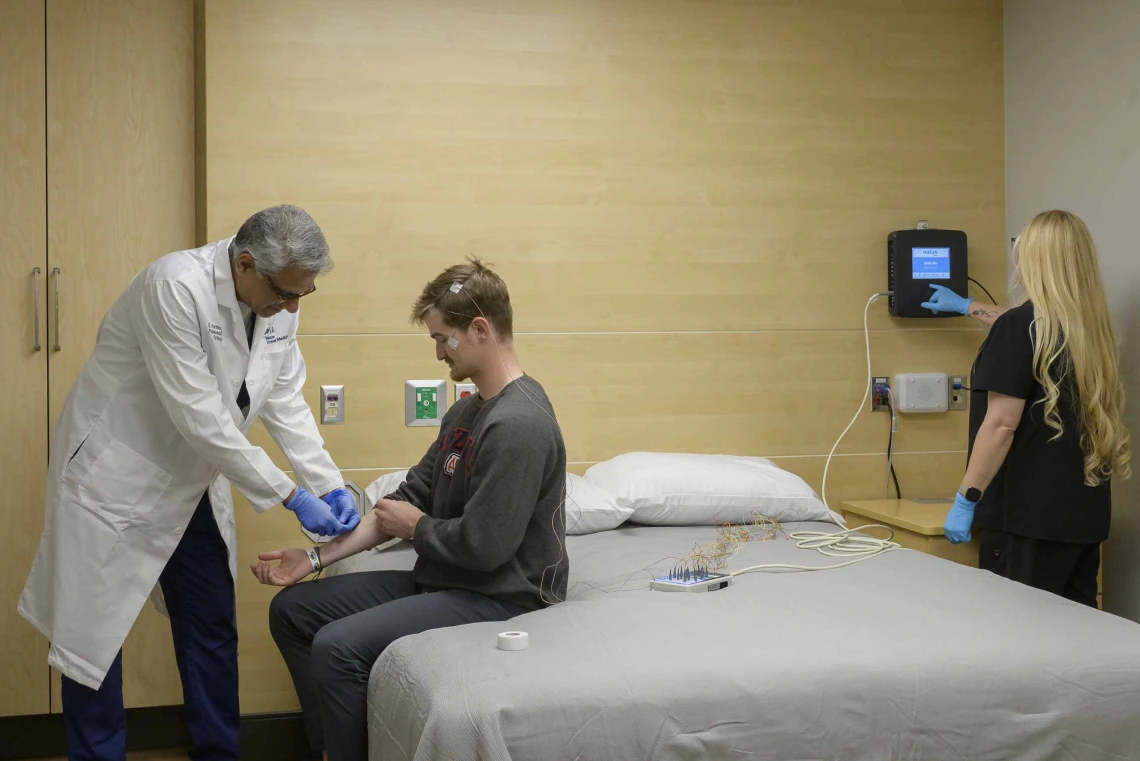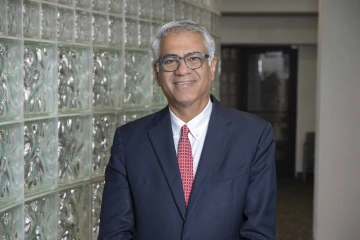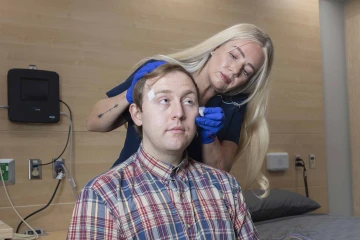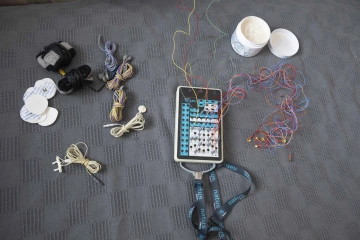Putting sleep at the center of health care
The career of physician-scientist Sairam Parthasarathy, MD, tracks with the evolution of sleep science.

Sairam Parthasarathy, MD, prepares a patient for a sleep study at the Center for Sleep, Circadian and Neuroscience Research.
Photo by Kris Hanning, U of A Office of Research and Partnerships
Like many doctors, Sairam Parthasarathy, MD, began his professional career by seeing patients as a clinician. Nearly 30 years later, he’s become a research authority on the hottest of health care topics: sleep.

Sairam Parthasarathy, MD, advances sleep medicine to improve health as the director of the Center for Sleep, Circadian and Neuroscience Research.
Photo by Noelle Haro-Gomez, U of A Health Sciences Office of Communications
Parthasarathy, director of the University of Arizona Center for Sleep, Circadian and Neuroscience Research, believes interest in sleep science is at an all-time high. It is a far cry from when he entered the burgeoning field of sleep science. Most people were not focused on sleep quality and didn’t realize it was a medical specialty.
“I felt sort of like a pariah,” said Parthasarathy, who faced bewilderment even from his wife when she asked about his work and learned it included watching videos of patients sleeping.
As a medical resident in 1998, Parthasarathy had little knowledge of sleep medicine himself. He was six months shy of graduating with credentials in critical and pulmonary care when he was called into his boss’ office at Loyola University Medical Center in Chicago. A colleague had left her post suddenly, and Parthasarathy was offered a job combining his existing knowledge with sleep medicine if he would take on an additional year of education.
He took the offer and worked at Loyola for the next five years. At that time, sleep medicine was building on key discoveries made from the 1970s on that gave physicians tools to diagnose and treat conditions including obstructive sleep apnea, insomnia and narcolepsy. The field has continually gained traction and prominence, according to research published in the Journal of Clinical Sleep Medicine, as evidenced by the growth of dedicated clinics, training programs, professional sleep societies, and a peer-reviewed journal.
Parthasarathy was working as a clinician helping people live healthier lives when a conversation with a mentor – renowned pulmonologist Martin J. Tobin, MD – opened his eyes to the benefits of research and academic medicine.
“I can see it in my mind’s eye,” Parthasarathy recalled. “We were in the ICU, and he said, ‘You’re taking care of individual patients and making an impact. With research, you can have bigger impact because now you’re affecting people’s sleep across the country, across the globe. You’re force-multiplying your reach.’”
Today, Parthasarathy still sees patients as a physician at Banner – University Medical Center Tucson. At the U of A, where he is a professor and chief of the Division of Pulmonary, Allergy, Critical Care and Sleep Medicine at the College of Medicine – Tucson, he studies topics including obstructive sleep apnea and circadian science with a demonstrated dedication to health equity.
Sustaining science that serves

Sicily La Rue, lead sleep technologist at the Center for Sleep, Circadian and Neuroscience Research, attaches sensors to a patient for a sleep study.
Photo by Noelle Haro-Gomez, U of A Health Sciences Office of Communications
“Sleep is connected to all the top killers or threats to quality of life – cancer, heart disease, motor vehicle accidents, strokes, Alzheimer’s disease,” said Parthasarathy, who collaborates with other scientists to uncover the far-reaching ways sleep affects health.
He led early research aimed at mitigating the effects of COVID-19 and long COVID and helped shape how long COVID is defined, diagnosed and managed, particularly through sleep-focused interventions. These efforts continue through two National Institutes of Health initiatives: Researching COVID to Enhance Recovery, or RECOVER, and Arizona Community Engagement Alliance, or CEAL.
Parthasarathy also developed and validated a peer support program to improve adherence to continuous positive airway pressure, or CPAP, therapy for people with obstructive sleep apnea. The program addresses two major hurdles in sleep medicine: sleep improvements require behavior change; and there is a relative shortage of specialists – only about 7,500 physicians in the United States are board-certified to see patients with sleep complaints, according to the American Academy of Sleep Medicine.
“Since there are not enough providers to manage sleep problems, we really need to champion the cause and send the right scientific messaging so people can learn.”
Parthasarathy’s peer support program, which was detailed in a paper in the American Journal of Respiratory and Critical Care Medicine, is now used in Banner Health clinics in Arizona and Colorado and by the American Sleep Apnea Association.
“Some research takes many years, but this has immediate benefits to people,” he said.

Sensors allow Parthasarathy and other sleep researchers to monitor brain activity, respiration and other physiological signals during sleep studies.
Photo by Noelle Haro-Gomez, U of A Health Sciences Office of Communications
In addition to research he leads, Parthasarathy collaborates with scientists around the country to advance sleep medicine. He is leading the Arizona site of a national clinical trial to test the effects of obstructive sleep apnea treatment on Alzheimer’s biomarkers. The ESSENTIAL study, funded by the NIH, is led by the California Pacific Medical Center Research Institute and includes researchers at the Icahn School of Medicine at Mount Sinai, New York University, the University of Pittsburgh and, of course, the U of A.
“The question is, if we treat the sleep apnea, can we reduce the rate of decline in participants’ Alzheimer’s trajectory?” Parthasarathy said. “That is what we are finding out.”
Looking ahead, Parthasarathy is eager to expand sleep research into how wearable devices and artificial intelligence can improve sleep and health. He recently testified before the House Committee on Veterans’ Affairs on implementing AI and other technologies to modernize VA health care. He highlighted the role AI could play in implementing research to benefit veterans and all Americans.
“There’s a huge amount of potential for that work,” he said.
Parthasarathy saw the invitation to testify as a rare opportunity to advocate for a branch of science he has only grown more committed to since that pivotal day in the ICU, when he decided to make research a priority and help people improve sleep for better health.
Experts
Sairam Parthasarathy, MD
Director, Center for Sleep, Circadian and Nueroscience Research
Professor, Department of Medicine, College of Medicine – Tucson
Chief, Division of Pulmonary, Allergy, Critical Care and Sleep Medicine, Department of Medicine, College of Medicine – Tucson
Professor, Clinical Translational Sciences, Mel and Enid Zuckerman College of Public Health
Member, BIO5 Institute

